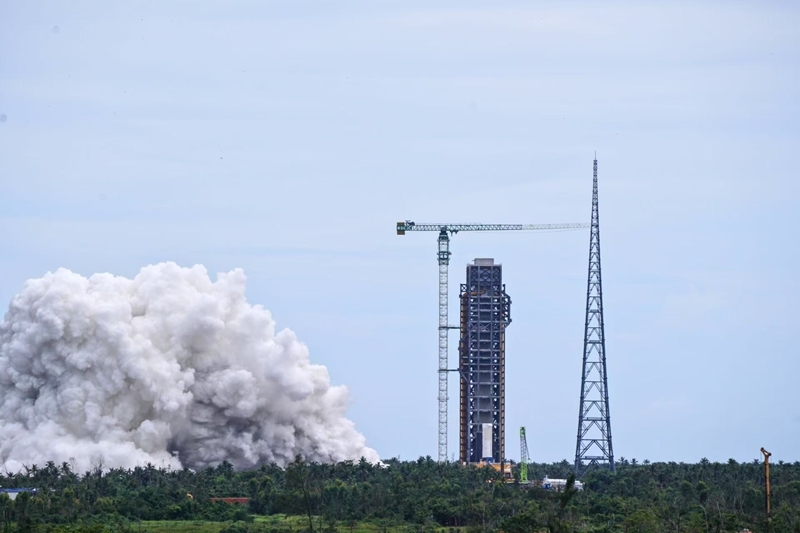Rocket engine test paves way for manned lunar mission


China conducted on Friday afternoon a key test on the propulsion system to be used in a new type of carrier rocket, which will be crucial in realizing China's plan to send astronauts to the moon.
During the ignition test at around 3 pm at the Wenchang Space Launch Center, a coastal spaceport in Hainan province, seven powerful engines, packed inside a prototype first stage of the Long March 10 rocket, were ignited, completing several tasks and generating a great deal of data, according to the China Manned Space Agency.
The agency said in a statement that the engines generated a massive combined thrust of nearly 1,000 metric tons during the event, setting a new domestic record for the most powerful engine ignition test.
Zhu Pingping, an engineer from China Aerospace Science and Technology Corp who took part in the test, said that in addition to the engines, the performance of heat-resistant structures and coating on the first stage was also checked and recorded during the test.
According to China Aerospace Science and Technology Corp, the Long March 10 is a brand-new type of launch vehicle and will be tasked with launching the country's new-generation crewed spacecraft and the lunar landing module.
The rocket is expected to be ready for its maiden flight around 2027.
The moon-mission rocket will consist of a core booster and several side boosters and will be 92.5 meters tall, which is roughly the height of a 32-story residential building, and five meters wide. The gigantic vehicle will have a liftoff weight of 2,189 metric tons and a thrust of 2,678 tons.
It will be capable of transporting spacecraft weighing at least 27 tons to an Earth-moon transfer trajectory, according to designers.
The rocket will also have a variant, the Long March 10A, which will not have side boosters. The Long March 10A, which will have a reusable first stage, will be 67 meters tall and have a liftoff weight of about 740 tons.
With a carrying capacity of 14 tons, it will be used to transport astronauts or cargoes to the Tiangong space station in low-Earth orbit, according to designers.
China's roadmap for its first manned lunar expedition involves two Long March 10 launches from the Wenchang spaceport to transport a landing module and a manned spacecraft into lunar orbit.
After reaching their preset orbital positions, the landing module and the spacecraft carrying astronauts will rendezvous and dock with each other. Two crew members will enter the landing module, which will then undock and descend toward the lunar surface for an engine-assisted soft landing.
On the lunar surface, the astronauts will drive a rover to carry out scientific tasks and collect samples. Upon the completion of their assignments, they will return to the landing module, which will fly them back to their spaceship waiting in lunar orbit.
In the final stage, the astronauts will carry the samples into their spacecraft, which will then undock and return the crew to Earth.
zhaolei@chinadaily.com.cn
- Rocket engine test paves way for manned lunar mission
- Exhibition in Taiwan commemorates 80th anniversary of victory in war against Japanese aggression
- Exhibitions, ceremonies mark 80th anniversary of Japan's WWII surrender
- China's air passenger trips total 440 million in first 7 months
- Academician Ji Xunming named president and deputy Party secretary
- 19 punished for role in medical admission case




































